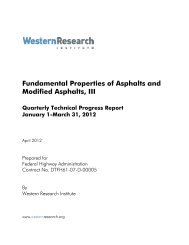Fundamental Properties of Asphalts and Modified Asphalts, III
Fundamental Properties of Asphalts and Modified Asphalts, III
Fundamental Properties of Asphalts and Modified Asphalts, III
Create successful ePaper yourself
Turn your PDF publications into a flip-book with our unique Google optimized e-Paper software.
greater than 100 micrometers are considered “thermally thick”). PAS directly measures IR<br />
absorption by sensing absorption induced heating <strong>of</strong> the sample within an experimentally<br />
controllable sample depth below the samples surface [McClell<strong>and</strong> et al. 2002].<br />
The PA sampling (thermal diffusion) depth for a homogeneous sample is conventionally<br />
expressed as [Rosencwaig <strong>and</strong> Gersho 1976]<br />
L π<br />
1<br />
2 = ( D / f )<br />
(2-2.2.1)<br />
where D is the thermal diffusivity, a measure <strong>of</strong> heat propagation speed, in cm 2 /sec, <strong>and</strong> f is the<br />
infrared-intensity modulation frequency in hertz. The equation for thermal diffusivity (D) is<br />
D = k/ρCp (2-2.2.2)<br />
where k is the thermal conductivity in W/mK, ρ is density in kg/m 3 , <strong>and</strong> Cp is the specific heat<br />
in J/kg K. From the literature it is estimated for an asphalt at 25˚C, typical values for ρ, k <strong>and</strong> Cp<br />
are 1030 kg/m 3 , 0.75 W/m K <strong>and</strong> 920 J/kg K, respectively. Frequency modulation ( f ) can be<br />
expressed as a function <strong>of</strong> V the optical path difference (OPD) velocity <strong>of</strong> the interferometer<br />
mirror in cm/sec <strong>and</strong> ν the wave number in cm -1 .<br />
f = Vν<br />
(2-2.2.3)<br />
Combining equations 2-2.2.1 <strong>and</strong> 2-2.2.3 results in<br />
1<br />
2<br />
L = ( D / πVν<br />
)<br />
(2-2.2.4)<br />
The sampling depth is inversely proportional to the square root <strong>of</strong> the modulation frequency <strong>and</strong><br />
therefore low modulation frequency or OPD velocity will result in PA signals from within the<br />
sample, while high OPD velocities are nearer the surface region. The dependence <strong>of</strong> the<br />
sampling depth on wavenumber (ν) means that it varies across a spectrum. For asphalt <strong>and</strong> the<br />
thermal diffusivity estimated above, at an OPD velocity <strong>of</strong> 0.5 cm/s the thermal diffusion length<br />
varies from 29 µm at 600 cm -1 to 11 µm at 4000 cm -1 . Thermal diffusion lengths at various<br />
OPD velocities <strong>and</strong> selected wave numbers from 600 to 4000 cm -1 corresponding to areas <strong>of</strong><br />
significant asphalt absorbance peaks are listed in table 2-2.2.1.<br />
Depth variation across the spectrum can be overcome by using a step-scan spectrometer<br />
employing phase modulation photoacoustic measurements [Jones <strong>and</strong> McClell<strong>and</strong> 1996;<br />
Drapcho et al. 1997]. Step-scan, as described by Drapcho et al. is the case where the “average<br />
optical retardation is adjusted stepwise, with a secondary, single-frequency phase (optical path<br />
difference) modulation applied. The data are collected when the average optical retardation is<br />
kept constant; thus the velocity <strong>and</strong> wavenumber dependence <strong>of</strong> the Fourier frequency is<br />
removed, <strong>and</strong> a constant probing depth across the spectrum for each phase modulation (PM)<br />
frequency is achieved.”<br />
15





